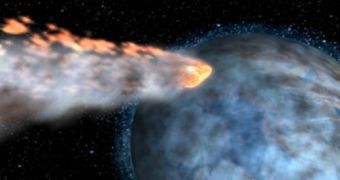A group of scientists discovered new compelling evidence of a cataclysmic event that took place 13,000 years ago on Earth. A large comet exploded over the Earth and created a hail of fireballs that set most of the Northern Hemisphere on fire.
After analyzing 26 different sites in Europe and North America, they found a layer of microscopic diamonds that are thought to be the remains of the giant comet, which must have contained important amounts of carbon. The huge heat and pressure from the blast arranged the carbon atoms in diamond structures.
"This comet set off a shock wave that changed Earth profoundly," said Arizona geophysicist Allen West. "It was about 2km-3km in diameter and broke up just before impact, setting off a series of explosions, each the equivalent of an atomic bomb blast. The result would have been hell on Earth. Most of the Northern Hemisphere would have been left on fire."
The massive explosion destroyed many Stone Age cultures around almost the entire Northern Hemisphere and wiped out populations of mammoths and other large terrestrial animals. Consequences of the explosions, according to the scientists, were felt throughout the world, which suffered a sudden cooling, lasting for 1000 years.
It could have been the reason why early human civilizations emerging in Europe and Asia suffered severe disruptions in their development.
"The shock waves and the heat would have been tremendous," said West. "It would have set fire to animals' fur and to human clothing. The searing heat would have also set fire to the grasslands of the Northern Hemisphere."
"Great grazing animals like the mammoth that had survived the original blast would have died later in their thousands from starvation. Only animals, including humans, that had a wide range of food would have survived the aftermath."
Diamonds are indeed known to form where space objects crashed down on Earth, having been found in impact craters and the surrounding shock zone. Microdiamonds are now used as one indicator of ancient meteorite impact sites.

 14 DAY TRIAL //
14 DAY TRIAL // 
